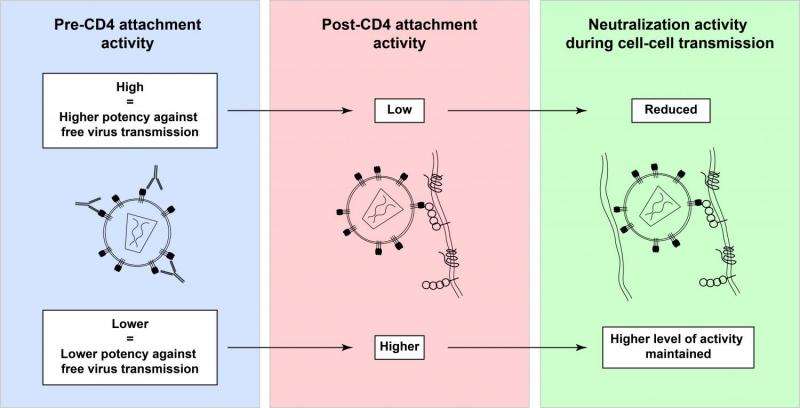Towards an HIV vaccine

Neutralizing antibodies (Nabs) are immune proteins that recognize, bind to, and trigger the elimination of virus before it can establish a chronic infection. How to elicit a potent Nab response capable of protecting against different HIV subtypes and against different modes of infection is critical to the development of an AIDS vaccine. Two studies published on July 9th in PLOS Pathogens provide results on Nabs that could help guide vaccine design. One shows what type of Nab "repertoire" can be generated following superinfection, and the second one examines the efficacy of Nabs in blocking direct cell-to-cell transmission of HIV.
Julie Overbaugh, from the Fred Hutchinson Cancer Research Center in Seattle, USA, and colleagues characterized the antibodies generated in 21 women who were superinfected, that is, infected sequentially at least twice with HIV by different sexual partners. Their study—the first to examine Nab specificities in a cohort of superinfected individuals, suggests that exposure to diverse HIV subtypes following superinfection may drive a broad and potent Nab response that might be mediated at least in part by polyclonal antibodies targeting multiple different epitopes, or antigenic targets found on the virus.
"As eliciting a highly diverse immune response may be favorable to providing protection against incredibly diverse HIV-1 variants in global circulation", the researchers conclude that their study "supports further investigations of the molecular and functional characteristics of the virus-antibody interplay in superinfected individuals, as superinfection may provide insight to the development of a diverse Nab response with multiple epitope specificities."
Besides infection with free virus, HIV can be transmitted also by direct cell-to-cell contact. And even though the latter is thought to provide a more difficult challenge for neutralizing antibodies, most of the studies so far have examined the antibodies in the context of free virus infections. To be able to address this gap, Alexandra Trkola, from the University of Zurich, Switzerland, and colleagues first developed an assay that can specifically test the ability and potency of Nabs to prevent direct cell transmission of HIV. Proving this point is tricky because free virus infection occurs normally together with cell-to-cell transmission. By establishing an assay system where free virus infection is restricted and infection can only occur through cell-cell transmission, the researchers could then test whether a large selection of Nabs could prevent cell-to-cell transmission of different HIV strains.
They found that while Nabs showed an overall decreased activity during cell-cell transmission, losses varied substantially depending on the antibody and the virus strain examined. A few Nabs retained activity during cell-cell transmission for individual viruses; surprisingly, this was generally not associated with a high potency against free virus infection. Neutralization of free virus, but not cell-cell transmission, was linked with the activity of specific Nabs to inhibit prior to the binding of the virus to the CD4 receptor on T cells, highlighting the functional differences of the two processes.
Using mathematical analysis, the researchers showed that cell-cell transmission was substantially more prone to give rise to virus mutants that can escape immune control than free virus transmission and conclude that "this highlights the importance of controlling virus replication via the cell-cell transmission pathway even if the contribution of this transmission mode should prove to occur to a lesser extent than free virus spread in infected individuals." They go on to say that "since no single broadly neutralizing antibody combines the entire range of mechanistic features anticipated to support in vivo efficacy, our study adds further evidence that combinations of such antibodies need to be considered for human application."
More information:
Overbaugh: dx.plos.org/10.1371/journal.ppat.1004973
Trkola: dx.plos.org/10.1371/journal.ppat.1004966
















